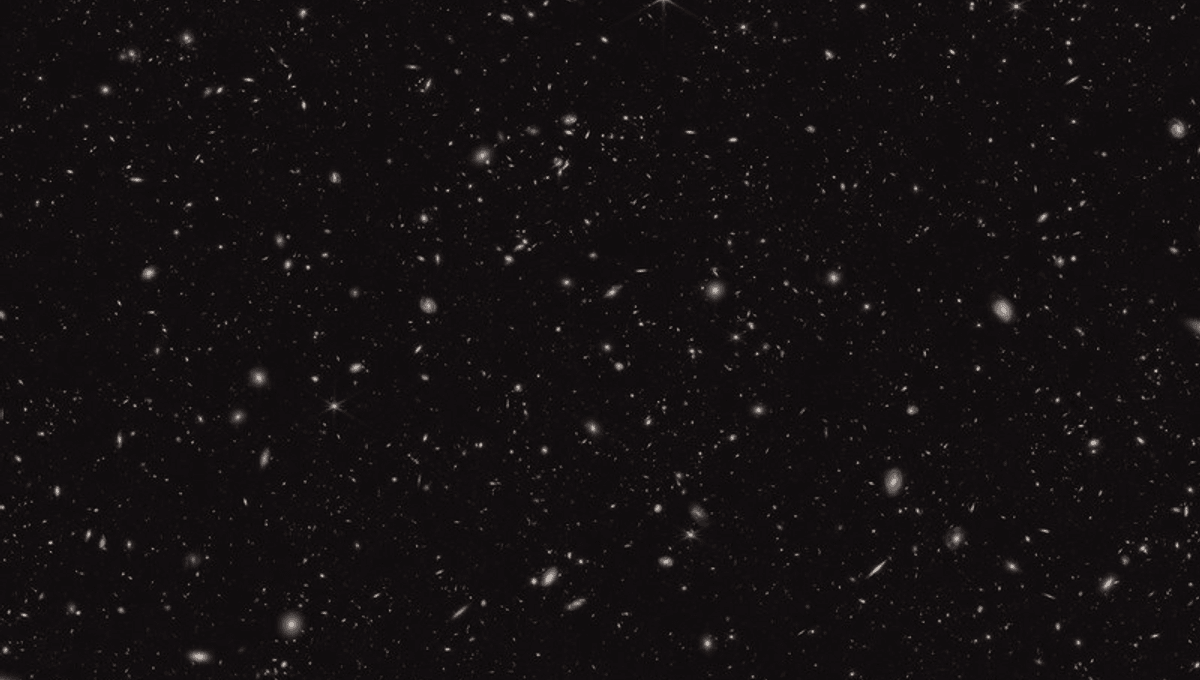
The bright galaxies the JWST has discovered existing unexpectedly soon after the Big Bang might be powered not by hydrogen fusing, as stars are today, but by concentrations of Dark Matter, physicists have proposed. These “Dark Stars” are claimed to have masses a million times that of the Sun. Don’t let the name fool you, however – astronomers think such stars would also be more than a billion times as bright as the Sun, explaining why we can see them over such vast distances.
Given that we don’t know what dark matter is composed of, any suggestion of its capacity to power sources of light is highly speculative. Nevertheless, some of the very early galaxies spotted by the JWST are difficult to explain, opening space for ideas previously considered fringe.
In a new paper, three physicists from Colgate University show how their idea of “Dark Stars” could explain some of the anomalies in the JWST’s observations.
The fact light is not infinitely fast means that seeing anything means looking back in time. The JWST has seen more distant galaxies than anything before it, and is therefore looking further back in time, almost to the Big Bang itself. These earliest galaxies appear to be more developed than conventional physics would suggest would be possible in the limited time available to them. Most physicists expect this paradox will be solved with relatively minor changes to existing models of the universe, but some are exploring more radical options.
The researchers propose the first stars were formed mostly from hydrogen and helium, like those in our own galaxy, but that concentrations of dark matter provided an energy source to heat them that initiated faster than fusion. So-called galaxies are instead single stars powered in this way to galactic brightness. At this distance, they argue, the JWST lacks the angular resolution to tell if it is seeing a point source or a more spread-out galaxy.
Dark Stars, according to the authors, are so large that if one replaced the Sun, its surface would be outside the orbit of Saturn. Even given their vast mass, fusion could not be sustained over such a larger area. Instead, Dark Matter particles annihilate themselves, releasing enough energy to heat the surface to 10,000 K (similar to Sirius), producing a staggering amount of light.
Such a release of energy can’t be sustained for long. The authors believe that when Dark Stars run out of dark matter to power themselves they collapse into black holes, providing the seeds for the supermassive black holes (SMBH) found at the core of galaxies. The presence of such developed SMBHs powering quasars in the early universe is another problem physicists are struggling to explain.
Although Dark Stars could resolve some of the problems in cosmology the JWST has brought to light, we don’t know whether Dark Matter particles are their own antiparticles and can therefore annihilate themselves as the authors propose. Even if they can, would stars of this nature be stable? Was the hydrogen and helium sufficiently clumped in the early universe to produce objects of the scale this proposal requires? Modeling may suggest the ideas are plausible, but as yet we have no evidence any of this is real.
Moreover, the paper acknowledges that one of the four early universe objects whose spectra has passed an initial suitability test could not fit the Dark Star model. If this object, JADES-GS-z10-0, is something more conventional than a Dark Star, critics might note, maybe the other three are as well.
However, the paper is more than speculative. The authors propose that if the other three objects in question are Dark Stars, their spectra should have distinctive helium lines, specifically an absorption line at 1640 Ångstroms, where a galaxy made of ordinary stars would have emission lines. So far, the JWST has not studied the three in enough detail to settle the matter. That’s something the authors would like to change.
The paper is published in Proceedings of the National Academies of Science.
Source Link: JWST May Have Found The First Evidence For "Dark Stars"